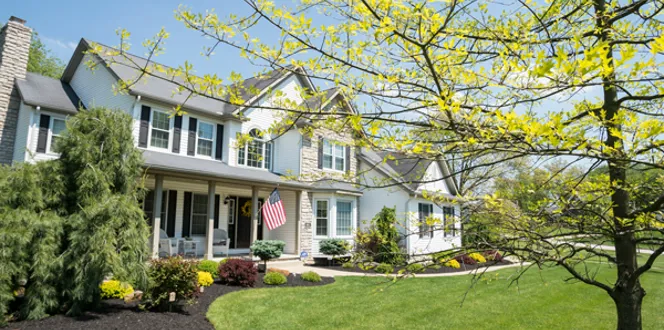Everybody wants to have a bright and healthy landscape. Vibrant landscapes are inviting and promote environmentally friendly practices. But selecting the right plants is an integral part of a landscape.
By doing a little research, you can find out exactly what flowers, trees, and shrubs will look the best in your yard while factoring in climate, temperature, and weather.
Whether you’re looking to plant trees and shrubs to create a natural privacy barrier, or just wanting to “spruce” up your property, read on to learn more about how to pick the plant that will thrive according to your location.
Choosing Hardy Trees & Shrubs For Your Landscape (By Zone)
The United States Department of Agriculture divided the United States and Canada into 11 hardiness zones or areas based on a 10-degree Fahrenheit difference in the average minimum temperature. The U.S. falls in zones 2-10.
These zones help gardeners and growers determine which plants are suitably hardy for the location’s environment. Local variations, such as moisture, soil, winds, and other conditions might also affect the viability of individual plants. Ask your local arborist about which trees to plant in your community.
Why is Hardiness Important?
Hardiness is the ability of the tree to survive the winter and still thrive and reproduce. A tree’s hardiness determines if it can be expected to grow in a certain zone’s temperature extremes as determined by the lowest average temperature in the zone.
Best Cold Hardy Trees
If you are looking to redesign or update your landscape, finding the plants that stay vibrant and healthy in the climate you live can be difficult or overwhelming. Here’s a list of recommended trees:
- Black Tupelo (Nyssa sylvatica) (Zone 4-9): Large, oval shaped tree, with furrowed bark and spectacular fall color.
- Serviceberry (Amelanchier) (Zones 3, 4): Oval-shaped tree with smooth gray-streaked bark and white upright flower clusters
- European beech (Fagus sylvatica) (Zone 4-7): Large, oval tree, with glossy leaves, provides shade and good fall color.
- Persian Parrotia (Parrotia persica) (Zone 5): A broadly pyramidal to rounded tree with showy, red flowers in the late winter and early spring that turn green in summer and a mix of yellow, orange, and red in the fall
- Bald Cypress (Taxodium distichum) (Zone 4-10): Large, pyramidal tree with feathery foliage that turns bronzy in the fall.
- White Spruce (Picea glauca) (Zone 2-6): Year-round color, columnar in shape, evergreen.
- Kentucky Coffeetree (Gymnocladus dioicus) (Zone 3-8): Adaptable, large oval tree with furrowed bark, pods, and yellow fall color.
Best Hardy Shrubs
Shrubs are an easily to maintain accessory that compliments any landscaping. They can act as borders to homes or pathways, build a foundation for larger landscape pieces, or just even stand on their own as ornamental plants. Here’s a list of recommended shrubs that will work in several different zones:
- Leucothoe (Zones 5-8): A deer-resistant evergreen native shrub with attractive flowers and colorful foliage
- Cherry laurel (Zones 6-9): An upright-standing shrub with dark green foliage and white flowers that give way to black berries
- Azaleas (Zones 6-9): Shrubs that have thicker, leathery leaves in evergreen variety and softer, more delicate leaves in their deciduous varieties.
- Yew (Zones 4-7): Evergreen shrub with softer foliage that is easily pruned and can be shaped to whatever form you want
- Mugo Pine (Zones 2-8): Slow-growing but unique shrub that stays small and contained, reaching a height of about 4 feet and spreading out up to 10 feet
Fast Growing Hardy Trees
If you miss planting season for your zone, there’s no need to fret! There are a number of shrub and tree species that are fast growing. Here is a list of fast-growing trees and shrubs we recommend:
- North Privet (Lingustrum x ibolium) (Zones 4-8): This hedge is known to be America’s fastest growing shrub, with a rate of up to 3 feet per year. The dense, dark, glossy, green foliage makes it a good choice for privacy screens.
- Green Giant Arborvitae (Thuja standishii x plicata) (Zones 5-7): This landscape tree grows as much as 3 feet per year until maturity. Its natural pyramidal form contains dense green foliage that darkens during the winter.
- Hybrid Poplar (Populus deltoides x Populus nigra) (Zones 3-9): Hybrid poplar trees have a vertical growth of 5 to 8 feet per year and can be harvested for firewood in 5 to 7 years.
- Blue Hydrangea (Hydrangea macrophylla) (Zones 6-9): The most commonly known hydrangea with large, long-lasting mophead blooms that appear in the summer. These shrubs work as stand-alones or as a hedge.
- Norway Spruce (Picea abies) (Zones 3-7): This tree can be used as lumber, pulpwood, Christmas trees, and landscape specimens. Its dense branching pattern and ability to tolerate different soil types make it a popular tree for windbreaks.







